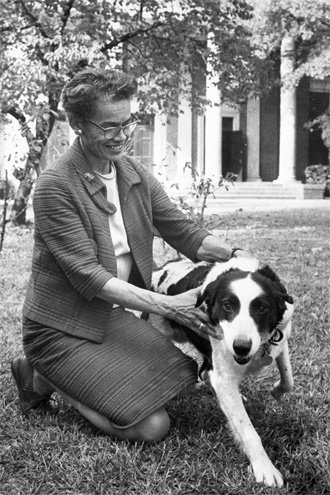Remembering Pauli Murray at Brandeis
The former Brandeis faculty member is an unsung hero of the Civil Rights Movement.
 Robert D. Farber Archives and Special Collections
Robert D. Farber Archives and Special CollectionsPauli Murray
Dr. Pauli Murray is recognized today as an unsung hero of the Civil Rights Movement, her writings on “separate but equal” forming many of the key arguments conveyed in Brown v. Board of Education, the 1954 Supreme Court case that ended school segregation.
But her contributions to society go even deeper. Murray was one of the original co-founders of the National Women’s Organization. She was a faith leader, serving as an Episcopalian priest, and a poet and writer of great acclaim.
Brandeis, too, can lay claim to part of Murray’s legacy.
Murray – born Anna Pauline Murray in Baltimore – taught at Brandeis from 1968 to 1973. She joined the faculty as a visiting professor in American Civilization, and went on to make innovative and profound contributions to the university’s scholarship and forge meaningful relationships with colleagues.
Two years into her time on campus, Murray successfully helped transition the American Civilization program into the American Studies program that exists today; she also created the first legal studies, African American studies and women’s studies courses at the university.
“She was definitely ahead of her time,” said Joyce Antler, the Samuel J. Lane Professor Emerita of American Jewish History and Culture and Professor Emerita of Women's, Gender and Sexuality Studies. “She came from real-world politics and activism, though Brandeis was new to her as well. She had never been at a liberal arts institution like this.”
Lawrence Fuchs, who co-founded Brandeis’ American Studies department, served as Murray’s mentor, and pushed for her to become tenured. Murray was also attracted to Brandeis because of its social justice roots and her deep friendship with former First Lady Eleanor Roosevelt, a Brandeis faculty member and Trustee.
“Pauli wanted to come to Brandeis because of what it was – because of the tradition about how it was founded,” added Antler. “She had a close friendship with Eleanor Roosevelt and great respect for President Morris Abrams. She fit in very well with the beginnings of American Studies. I think Larry Fuchs understood that her real-world activism and her role in the civil rights movement and feminism would be instructive for students. When she came, she was encouraged to innovate.”
Murray is one of many activists and public intellectuals to have made their way to Brandeis throughout the university’s 70-year history, joining a robust group that also includes Martin Luther King Jr., Malcolm X, Julian Bond, Geoffrey Canada, Roosevelt and countless others.
That said, Antler, like many other historians, is disappointed that Murray’s life and legacy remain relatively unknown.
“It’s disheartening,” said Antler. “She bridged so many movements and periods and was an activist and leader in so many areas – the legal world, feminism, civil rights. Perhaps her versatility and deep involvement in many things make the breadth of her contributions difficult to acknowledge.”
“She was not one to take the limelight at Brandeis and she was only here for a few years, moving on to become the first ordained female Episcopal priest,” Antler added. “She was also a writer and poet of great talent. She had multiple interests and pathways. You can’t pigeon-hole her.”
Even so, Murray managed to mix her expertise in law and her passion for women’s rights and civil rights effectively at Brandeis. Antler sees Murray as one leader in a coalition of faculty women on campus at the time who worked with students to bring issues of gender inequity to light.
“The students today will identify with this: she believed that when something was wrong you had to act to correct it,” Antler said. “You get info. You gather data. And then you organize to protest. You don’t sit still.”
Categories: General, Humanities and Social Sciences





